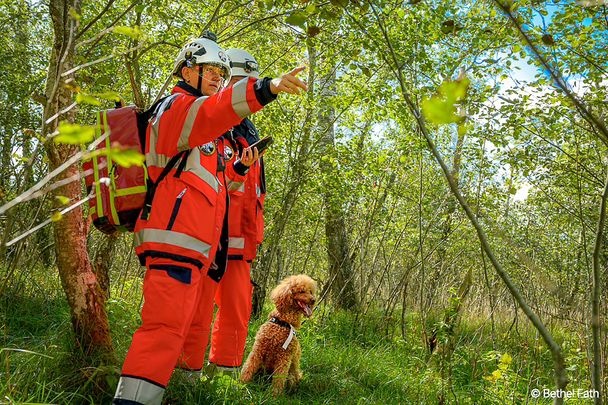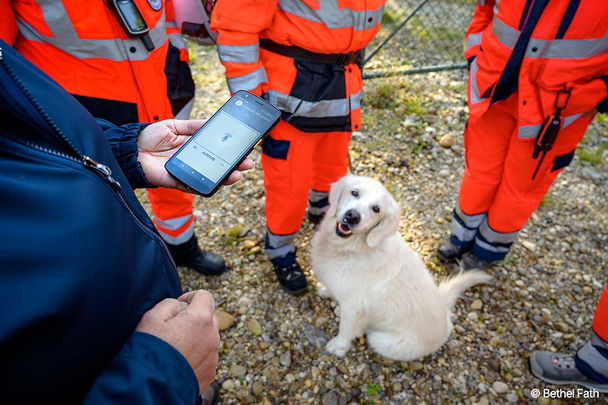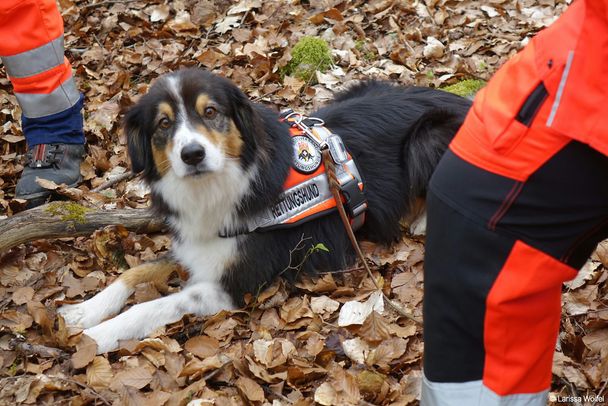Communication saves lives: How Airbus solutions support Bavarian rescue dog teams

In the dense forests of Lower Bavaria, private rescue dog teams count on Airbus support for mission-critical communication. This is all part of a project that is examining the use of digital radio in rural areas.
Anna-Maria Demmert and Loni Saxinger’s dogs don’t chase through the undergrowth for fun. As volunteers with the Deggendorf and Zwiesel rescue dog teams, Demmert and Saxinger rely on their dogs’ strong noses to rescue people. They search for missing persons in the dense forests of Lower Bavaria alongside their colleagues. “The missing people include injured hikers, suicidal people and people with dementia,” says Demmert.
Rescue teams use area search dogs to search large swathes of forest ranging from 40,000 to 60,000 square metres. “In contrast to mantrailing dogs, which focus on the specific smell of the person they are looking for, area search dogs detect all human smells,” explains Demmert. Capable of combing large areas quickly, the dogs are particularly effective in hard-to-navigate areas.

Rescue dog teams testing the use of broadband as part of a research project evaluating digital radio communication and ways to cover dead spots in the German countryside.
Communication is key
The team leader is responsible for planning the operation and divides the search area among the dog handlers using topographical maps. “When we start a mission, we only have a limited overview of what we can actually expect in the search area,” says Loni Saxinger. “For example, a fallen tree or dense undergrowth could be blocking our path.”
Communication is key in ensuring the entire operation runs as effectively as possible. “We need to share information constantly for live updates about the search progress so we can react to situations quickly,” explains Saxinger. There is no time to waste when the dogs or dog handlers need help during an operation. “Without reliable communication, valuable time is lost in an emergency.”
The rescue dog teams count on Agnet, the Airbus smartphone communication solution. Using Agnet, teams can communicate quickly via 4G and 5G to coordinate operations. “In the past, we had to carry heavy radios,” says Saxinger. “We now use Agnet on a compact Android device that can send pictures and text messages as well as radio messages. This gives our team leaders an accurate picture of the situation on site.”
A technological leap for effective help
The rescue dog teams were introduced to Agnet as part of a research project evaluating the use of digital radio communication and ways to cover dead spots in the German countryside. The association supporting Bavarian search and rescue dog teams (Förderverein für einsatzorientierte, gemeinnützige Rettungshundestaffeln e.V.) and the Deggendorf Institute of Technology are also involved in the project.

The rescue dogs search huge areas in the Bavarian forest where mobile phone service is not always available.
The project aims to improve communication during critical search and rescue operations. Private rescue dog teams in Bavaria are not able to use the digital radio network normally used by Germany’s first responders, and rely mainly on analogue point-to-point communication. The project is now providing for the switch to broadband mobile networks. “Analogue radio has a limited range. Transmission quality is often poor and conversations can be easily intercepted,” explains Andreas Kellringer, Chairman of the association supporting Bavarian search and rescue dog teams.
Agnet has provided participants with a solution that fulfils the project’s key requirements:
- Using mobile phone networks for optimal availability.
- Securing communication that is end-to-end encrypted and cannot be intercepted.
- Using smartphones as a communication device for cost efficiency.
- Open interfaces to integrate data into other solutions.
“Our training costs are virtually zero with Agnet,” says Kellringer. “You put it in the hands of first responders and they can get started.”
Effective network coverage in rural areas
All that said, critical communication is only as good as the available network. “Despite the great coverage provided by public mobile phone networks, we still struggle with dead spots in rural areas,” says Kellringer. “Even with 5G, we will never
achieve full coverage.” The project is therefore also looking to fill these gaps by using supplementary transmission channels such as LoRaWan (Long Range Wide Area Network) and wireless LAN.

Agnet enables secure group radio on smartphones
Together with Airbus, the project participants are evaluating the use of a mesh network in this context. Emergency services carry Wi-Fi devices with them. The devices connect to each other at certain distances to pass on relevant information. Kellringer explains: “Emergency services use 5G when it’s available. When it isn’t, they switch to the mesh network.” Initial tests proved the feasibility of this in summer 2024, but upcoming range tests will be decisive. “We need to ensure we can also cover large and hard-to-navigate areas with this approach,” says Kellringer.
Working towards the proof of concept
The joint project runs until the end of 2025. “We should have a proof of concept by the end of the project, and it should also be applicable beyond rescue dog teams – to other emergency services or in rural areas generally,” says Kellringer.
He is already pleased with the results. “We are showing how critical communication can be made possible even under difficult conditions with poor network coverage.” This won’t simply be a short foray into the world of digital radio for the rescue dog teams. “We are working towards providing all private rescue dog teams in Bavaria with Agnet-based digital radio equipment in the medium term.”
